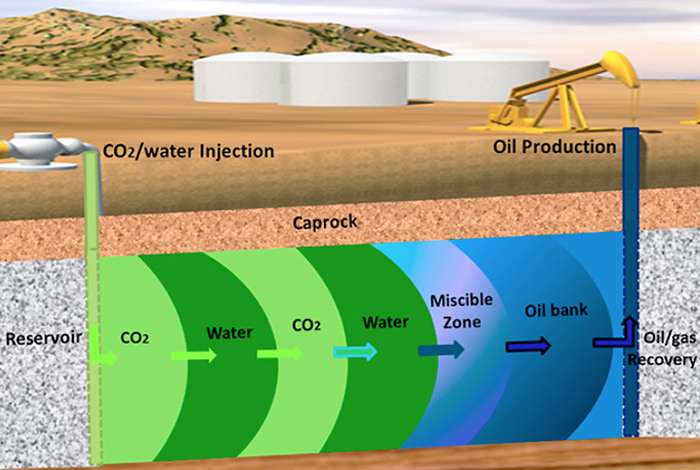Risk analysis for CO2 sequestration at enhanced oil recovery sites

Carbon dioxide (CO2) is an attractive displacing agent for enhanced oil recovery. Because a large portion of the injected CO2 remains in place in depleted reservoirs after enhanced oil recovery, this method could also be an option for permanently sequestering CO2 to mitigate global warming. Los Alamos scientists and collaborators have developed a generic multi-scale statistical framework for CO2 accounting and risk analysis in CO2-enhanced oil recovery sites. This analysis method provides information to aid decision-making for applications of oil recovery and CO2 sequestration. Environmental Science & Technology published the research.
The CO2 enhanced oil recovery process presents potential benefits and some technical and operational challenges. The very low viscosity of CO2 may cause it to break through to production wells, and poor mobility control may leave large areas of the reservoir unswept. To overcome this disadvantage, current CO2 enhanced oil recovery projects alternately inject gas and water (or brine) as slugs in the water-alternating-gas method to control CO2 mobility and flood conformance. This method can be very effective. However, more detailed studies of the interaction of CO2 with oil, formation water, and heterogeneous sediments are needed to understand the mechanism of CO2 geological sequestration in oil/gas reservoirs and evaluate the total amount of CO2 irreversibly stored in reservoirs.
The exact values of the reservoir parameters are not well known in most CO2-enhanced oil recovery sites. However, enough information may be obtained to define the uncertainty distributions of these parameters. The research team used these distributions to perform multi-scale simulations of the CO2-oil-water flow and transport. The investigators expressed the risk factors as measurable quantities to gain insight into project risk (e.g., environmental and economic risks). This approach eliminated the need to generate a rigorous consequence structure of CO2 injection rate, cumulative CO2 storage, cumulative water injection and cumulative oil/gas production. The results provide insights to understand CO2 storage potential and the corresponding environmental and economic risks of commercial-scale CO2 sequestration in depleted reservoirs.
The researchers used the CO2 enhanced oil recovery site in the Farnsworth Unit in Texas to investigate their multiscale statistical approach for CO2 accounting and risk analysis. The exact values of the reservoir parameters are not well known. Therefore, the team used distributions to sample the uncertain parameters and conduct geostatistical-based Monte Carlo simulations.
The researchers performed multi-scale simulations of the CO2-oil-water flow and transport in the heterogeneous reservoir. They used a pattern of four injection wells in the corners of a square and a production well in the center. The team conducted 1000 separate reservoir simulations, including injected CO2 and water as well as produced CO2, water, oil and gas. The investigators developed a simple economic model to calculate the profitability of CO2-enhanced oil recovery for the site. This information aids understanding of the impact of the reservoir heterogeneity and other operational parameters for economic decision-making and the cost-effectiveness of CO2 sequestration through enhanced oil recovery at other depleted reservoirs.
More information: Zhenxue Dai et al. COAccounting and Risk Analysis for COSequestration at Enhanced Oil Recovery Sites, Environmental Science & Technology (2016). DOI: 10.1021/acs.est.6b01744
Journal information: Environmental Science & Technology
Provided by Los Alamos National Laboratory
















